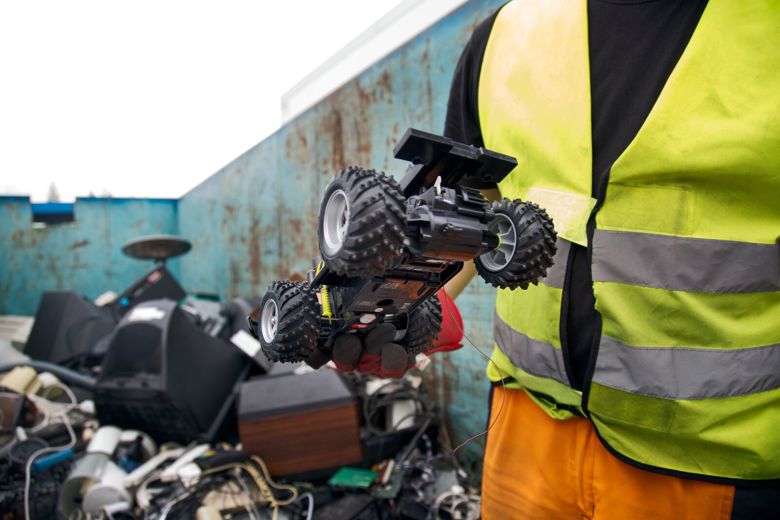HSY's Sortti collection vehicles to tour from 31 March

The collection vehicles of the Helsinki Region Environmental Services will be operating again in the spring. During the tour starting at the end of March, the vehicles will stop in different parts of the Helsinki Metropolitan Area and Kirkkonummi. Residents can bring domestic hazardous waste, electric and electronic devices and scrap metal to the vehicles free of charge.
This spring, HSY’s Sortti collection vehicles will once again accept domestic hazardous waste, electric and electronic devices and scrap metal. During the ten-week tour, the vehicles will stop at a total of 292 reception sites around the Helsinki Metropolitan Area and Kirkkonummi. The tour will start in Helsinki and Espoo at the end of March. The collection vehicles will be in Helsinki from 31 March to 26 May and in Espoo from 31 March to 5 May. In addition, the vehicles will be in Kauniainen on 16 April and 22 April, in Vantaa from 6 May to 3 June and in Kirkkonummi from 27 May to 4 June. The exact schedules and stops and the stop map are available on HSY’s website.
– The Sortti collection vehicle tour offers residents a free and environmentally friendly way to bring domestic waste to a collection point. The collection tour will once again cover the whole area extensively so that the service can also reach those residents who don't have cars, says Joonas Enqvist, HSY’s Operational Manager.
Each type of waste has its own collection vehicle
Only domestic hazardous waste, electric and electronic devices and scrap metal can be brought to the Sortti collection vehicles. Each type of waste has its own collection vehicle. To make the collection process smoother, it is advisable to sort the waste separately already at home.
Domestic hazardous waste includes, for example, paints, varnishes, plasters, motor oil, petrol, solvents, corrosive chemicals, pesticides and batteries. Examples of everyday cosmetic products that are hazardous waste are hairspray, nail polish and perfume. Domestic scrap metal includes, for example, frying pans, laundry racks and metal furniture.
Electric and electronic devices include, for example, washing machines, televisions, coffee machines, electric sauna stoves, electric toothbrushes, telephones and computers. However, when it comes to smart devices, it should be noted that the information security of the devices cannot be guaranteed during the collection tour. If necessary, you can use an information security service such as Seiffi.fi to dispose of devices securely.
– The Sortti collection vehicle tour is aimed at less frequently generated domestic waste that does not have a collection container at the property or at the Rinki eco-take-back points. Waste that is too large for the existing containers can also be brought to the collection vehicles. You can turn to HSY’s Waste guide for sorting assistance. In addition, environmental advisors will be on site to assist you. The environmental advisers can be identified by HSY’s yellow high-visibility vest, says Enqvist.
The collection vehicles will stop at each reception site for 30–40 minutes
When arriving to the collection vehicles, it is good to keep in mind that hazardous waste must be delivered to the collection vehicles in their original packaging or in another intact and sealed container marked with what it contains. Other carton and plastic packaging, such as plastic bags used to transport waste, are sorted into the collection containers at home or at a Rinki eco take-back point, as there is no space for them in the vehicles.
– If you arrive by car, it is advisable to park further away so that the collection vehicles can be accommodated at the stop. Waste must be brought directly to the collection vehicle and must not be left at the reception site in advance. If there is a larger quantity of such waste fractions, such as a trailer load, they must be delivered directly to a Sortti Station, where their reception is free of charge for private customers, says Enqvist.
What happens to the waste brought to the collection vehicles?
HSY ensures that all waste brought to the collection vehicles is recycled. For example, scrap metal and electric and electronic devices are reused as raw materials for new products. Some hazardous waste can also be recycled. The rest of the hazardous waste is rendered harmless during processing so that it does not cause harm to people, animals or the environment. Hazardous waste must never be put in mixed waste, down the drain or in the environment.
The collection vehicles of the Helsinki Metropolitan Area Reuse Centre will also be on the move in the spring
At the same time, the Helsinki Metropolitan Area Reuse Centre will organise its own collection tour, collecting clean, undamaged small household items and textiles suitable for reuse as well as small electric and electronic devices and bicycles regardless of their condition. Further information and the schedules can be found on the Reuse Centre's website.